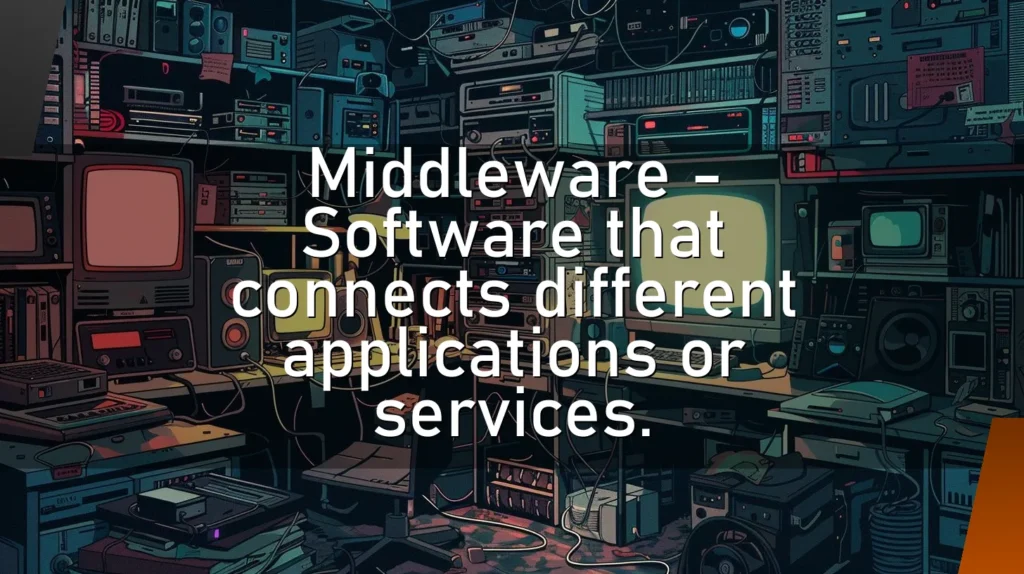Middleware: Software that Connects Different Applications or Services
Introduction
Imagine you’re at a party🎉. One group is discussing quantum physics, another is debating the best pizza toppings🍕, and there’s that one guy who just won’t stop talking about his cat’s Instagram account😸. How do these groups communicate? They need a social butterfly—a middleman who can flit between conversations and relay messages. In the tech world, that social butterfly is called middleware. But before we dive in, let’s deconstruct this enigmatic jargon.
How a Nerd Would Describe It
A nerd might say: "Middleware operates at the intersection of application and network layers, providing a run-time environment and assorted services like transaction processing, messaging, and authentication to facilitate seamless inter-process communication across different applications and services."
Or as a normal human might interpret it: "Middleware is like a translator for your software, making sure everything talks to each other smoothly."
This Chapter is for a Simple but Concrete Explanation
Think of middleware as the glue🧴 that holds various software applications together. It’s the unsung hero🥇 working behind the scenes, ensuring everything runs seamlessly. Whether you’re streaming cat videos or managing your finances, middleware ensures different software components play nicely with each other.
🔍 Details
Middleware is essential, especially in complex systems where multiple services need to communicate. For example, in an e-commerce platform, middleware might manage inventory, user authentication, and payment processing. It’s the silent operator making sure your credit card info goes to the right place and not to a Nigerian prince🤑.
Other Similar Words Which Nerds Use
- API Gateway: Think of it as the front desk receptionist📞, directing calls to the appropriate office.
- Message Broker: Like a post office📬, it ensures messages get from sender to recipient.
- Enterprise Service Bus (ESB): The bus driver🚌 for data between software applications.
👍 Correct Usage
Correct usage of middleware can be as simple as saying: "Our new application leverages middleware to connect the front-end interface with the back-end database."
🛑 Wrong Usage
Incorrect usage would be: "I used middleware to fix my printer." No, unless your printer is part of a complex network of applications, middleware is not your go-to solution.
➕ Advantages
- Scalability: Middleware allows systems to grow without breaking a sweat💪.
- Interoperability: It enables different software components to communicate, regardless of language or platform.
- Reliability: Middleware ensures messages are delivered, even if some parts of the system fail.
➖ Disadvantages
- Complexity: Middleware can add an additional layer of complexity, making troubleshooting a bit like finding Waldo in a haystack.
- Cost: Implementing and maintaining middleware can be expensive💸.
- Performance Overhead: Middleware can introduce latency due to the extra processing involved.
⁉️ FAQ
What Are Some Common Examples of Middleware?
- Database Middleware: Connects applications to databases.
- Message-Oriented Middleware (MOM): Like RabbitMQ, it helps applications send messages to each other smoothly.
- Application Servers: Such as JBoss or WebSphere, which provide an environment for running specific applications.
Is Middleware Necessary for All Systems?
Not really. If you’re working with a simple, stand-alone application, middleware might be overkill. But for complex, integrated systems, it’s a lifesaver🦸.
How Does Middleware Improve Security?
Middleware can handle authentication and authorization, ensuring that only the right people get access to sensitive information🔒.
👌 Conclusion
To sum it all up, middleware is the tech world’s unsung hero. It’s the glue, the translator, the social butterfly that makes sure all your software applications communicate effectively. While it comes with its own set of challenges—like complexity and cost—the benefits far outweigh the drawbacks, especially in complex, integrated systems.
So next time you’re streaming your favorite TV show📺 or completing a digital transaction💳, remember, there’s a good chance middleware is working behind the scenes, keeping everything running smoothly.
And if you ever find yourself at a party with people discussing middleware, just remember: it’s the software equivalent of a social butterfly. Now you can join in the conversation, or at least nod wisely and say, "Ah yes, middleware. The unsung hero of the tech world."







